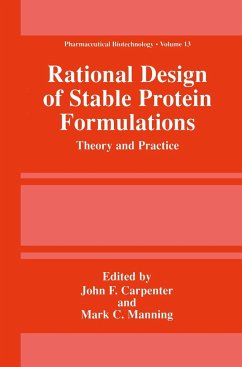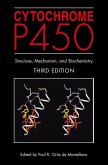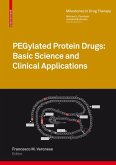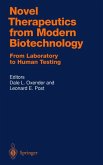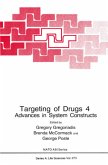John F. Carpenter / Mark C. Manning (Hgg.)Theory and Practice
Rational Design of Stable Protein Formulations
Theory and Practice
Herausgegeben:Carpenter, John F.; Manning, Mark C.
John F. Carpenter / Mark C. Manning (Hgg.)Theory and Practice
Rational Design of Stable Protein Formulations
Theory and Practice
Herausgegeben:Carpenter, John F.; Manning, Mark C.
- Gebundenes Buch
- Merkliste
- Auf die Merkliste
- Bewerten Bewerten
- Teilen
- Produkt teilen
- Produkterinnerung
- Produkterinnerung
Recombinant proteins and polypeptides continue to be the most important class of biotechnology-derived agents in today's pharmaceutical industry. Over the past few years, our fundamental understanding of how proteins degrade and how stabilizing agents work has made it possible to approach formulation of protein pharmaceuticals from a much more rational point of view.
This book describes the current level of understanding of protein instability and the strategies for stabilizing proteins under a variety of stressful conditions.
Andere Kunden interessierten sich auch für
![Novel Therapeutics from Modern Biotechnology Novel Therapeutics from Modern Biotechnology]() Novel Therapeutics from Modern Biotechnology242,99 €
Novel Therapeutics from Modern Biotechnology242,99 €![Free Radicals in Diagnostic Medicine Free Radicals in Diagnostic Medicine]() Free Radicals in Diagnostic Medicine39,99 €
Free Radicals in Diagnostic Medicine39,99 €![Cytochrome P450 Cytochrome P450]() Cytochrome P45086,99 €
Cytochrome P45086,99 €![PEGylated Protein Drugs: Basic Science and Clinical Applications PEGylated Protein Drugs: Basic Science and Clinical Applications]() PEGylated Protein Drugs: Basic Science and Clinical Applications155,99 €
PEGylated Protein Drugs: Basic Science and Clinical Applications155,99 €![Novel Therapeutics from Modern Biotechnology Novel Therapeutics from Modern Biotechnology]() Novel Therapeutics from Modern Biotechnology242,99 €
Novel Therapeutics from Modern Biotechnology242,99 €![Targeting of Drugs 4 Targeting of Drugs 4]() GregoriadisTargeting of Drugs 4121,99 €
GregoriadisTargeting of Drugs 4121,99 €![Encyclopedia of the Alkaloids Encyclopedia of the Alkaloids]() John GlasbyEncyclopedia of the Alkaloids81,99 €
John GlasbyEncyclopedia of the Alkaloids81,99 €-
-
-
Recombinant proteins and polypeptides continue to be the most important class of biotechnology-derived agents in today's pharmaceutical industry. Over the past few years, our fundamental understanding of how proteins degrade and how stabilizing agents work has made it possible to approach formulation of protein pharmaceuticals from a much more rational point of view.
This book describes the current level of understanding of protein instability and the strategies for stabilizing proteins under a variety of stressful conditions.
Hinweis: Dieser Artikel kann nur an eine deutsche Lieferadresse ausgeliefert werden.
This book describes the current level of understanding of protein instability and the strategies for stabilizing proteins under a variety of stressful conditions.
Hinweis: Dieser Artikel kann nur an eine deutsche Lieferadresse ausgeliefert werden.
Produktdetails
- Produktdetails
- Pharmaceutical Biotechnology 13
- Verlag: Springer / Springer US / Springer, Berlin
- Artikelnr. des Verlages: 978-0-306-46741-7
- 2002
- Seitenzahl: 228
- Erscheinungstermin: 30. April 2002
- Englisch
- Abmessung: 241mm x 160mm x 17mm
- Gewicht: 499g
- ISBN-13: 9780306467417
- ISBN-10: 0306467410
- Artikelnr.: 22303318
- Herstellerkennzeichnung Die Herstellerinformationen sind derzeit nicht verfügbar.
- Pharmaceutical Biotechnology 13
- Verlag: Springer / Springer US / Springer, Berlin
- Artikelnr. des Verlages: 978-0-306-46741-7
- 2002
- Seitenzahl: 228
- Erscheinungstermin: 30. April 2002
- Englisch
- Abmessung: 241mm x 160mm x 17mm
- Gewicht: 499g
- ISBN-13: 9780306467417
- ISBN-10: 0306467410
- Artikelnr.: 22303318
- Herstellerkennzeichnung Die Herstellerinformationen sind derzeit nicht verfügbar.
1 Practical Approaches to Protein Formulation Development.- Preparation for Formulation Development.- Preformulation Development.- Formulation Development.- Formulation in Commercial Product Development.- Appendix: List of Regulatory Documents.- References.- 2 Recombinant Production of Native Proteins fromEscherichia coli.- Distribution of Expressed Proteins.- Cell Washing and Lysis.- Purification of Soluble, Folded Proteins.- Purification and Refolding of Soluble, Misfolded Proteins.- Purification and Refolding of Proteins from Inclusion Bodies.- Refolding Mechanism.- Methods to Analyze Folded Structures.- References.- 3 Physical Stabilization of Proteins in Aqueous Solution.- Overview of Physical Stability.- Interactions of Excipients with Proteins.- Physical Factors Affecting Protein Stability.- Conclusions.- Appendix: Derivation of the Wyman Linkage Function and Application to the Timasheff Preferential Exclusion Mechanism.- References.- 4 Effects of Conformation on the Chemical Stability of Pharmaceutically Relevant Polypeptides.- Relationship Between Structure and Deamidation Rates.- Role of Structure in Protein Oxidation.- Summary.- References.- 5 Rational Design of Stable Lyophilized Protein Formulations: Theory and Practice.- Minimal Criteria for a Successful Lyophilized Formulation.- Rational Design of Stable Lyophiilized Formulations.- Acknowledgments.- References.- 6 Spray-Drying of Proteins.- Introduction: Why Spray-Dry a Protein?.- Developments in the Last 10 Years.- The Practice of Spray-Drying Proteins.- Concluding Remarks.- References.- Chapter7 Surfactant-Protein Interactions.- Proteins and Surfactants at Surfaces.- Protein-Surfactant Interactions in Solution.- Surfactant Effects on Protein Assembly State.- Surfactant Effects on Proteins During Freezing, Freeze-Drying and Reconstitution.- Enzymatic Degradation of Non-Ionic Surfactants.- Recommendations for Protein Formulation.- References.- 8 High Throughput Formulation: Strategies for Rapid Development of Stahle Protein Products.- Overall Structure of the HTF Approach.- Role of an Established Decision Tree for Formulation Design.- Use of Software and Databases to Assist in the HTF Process.- Essential Analytical Methods.- Stability Protocols.- Unified Strategy for HTF.- References.
1 Practical Approaches to Protein Formulation Development.- Preparation for Formulation Development.- Preformulation Development.- Formulation Development.- Formulation in Commercial Product Development.- Appendix: List of Regulatory Documents.- References.- 2 Recombinant Production of Native Proteins fromEscherichia coli.- Distribution of Expressed Proteins.- Cell Washing and Lysis.- Purification of Soluble, Folded Proteins.- Purification and Refolding of Soluble, Misfolded Proteins.- Purification and Refolding of Proteins from Inclusion Bodies.- Refolding Mechanism.- Methods to Analyze Folded Structures.- References.- 3 Physical Stabilization of Proteins in Aqueous Solution.- Overview of Physical Stability.- Interactions of Excipients with Proteins.- Physical Factors Affecting Protein Stability.- Conclusions.- Appendix: Derivation of the Wyman Linkage Function and Application to the Timasheff Preferential Exclusion Mechanism.- References.- 4 Effects of Conformation on the Chemical Stability of Pharmaceutically Relevant Polypeptides.- Relationship Between Structure and Deamidation Rates.- Role of Structure in Protein Oxidation.- Summary.- References.- 5 Rational Design of Stable Lyophilized Protein Formulations: Theory and Practice.- Minimal Criteria for a Successful Lyophilized Formulation.- Rational Design of Stable Lyophiilized Formulations.- Acknowledgments.- References.- 6 Spray-Drying of Proteins.- Introduction: Why Spray-Dry a Protein?.- Developments in the Last 10 Years.- The Practice of Spray-Drying Proteins.- Concluding Remarks.- References.- Chapter7 Surfactant-Protein Interactions.- Proteins and Surfactants at Surfaces.- Protein-Surfactant Interactions in Solution.- Surfactant Effects on Protein Assembly State.- Surfactant Effects on Proteins During Freezing, Freeze-Drying and Reconstitution.- Enzymatic Degradation of Non-Ionic Surfactants.- Recommendations for Protein Formulation.- References.- 8 High Throughput Formulation: Strategies for Rapid Development of Stahle Protein Products.- Overall Structure of the HTF Approach.- Role of an Established Decision Tree for Formulation Design.- Use of Software and Databases to Assist in the HTF Process.- Essential Analytical Methods.- Stability Protocols.- Unified Strategy for HTF.- References.

